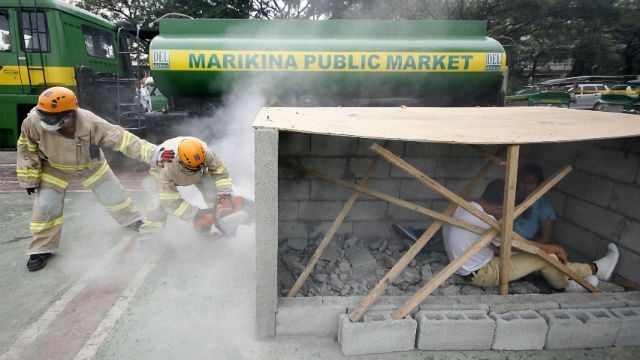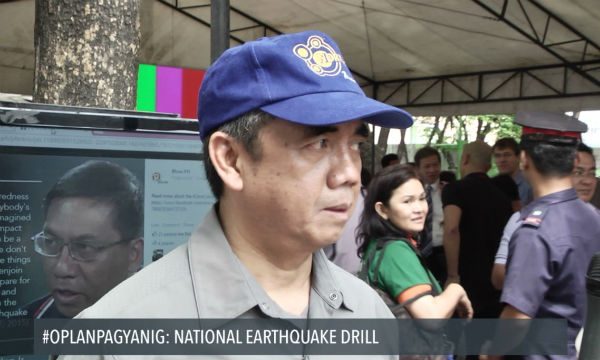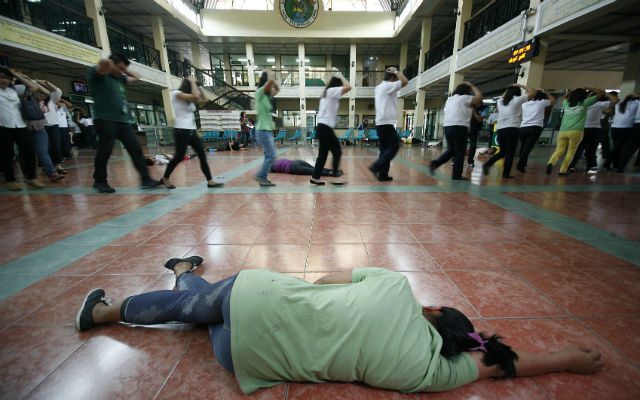SUMMARY
This is AI generated summarization, which may have errors. For context, always refer to the full article.

MANILA, Philippines – Debris from collapsed infrastructure line the streets of Marikina. What was once the local government unit’s (LGU) capitol has turned into a crisis and evacuation center in a matter of minutes. Firetrucks and ambulances with loud sirens rush to nearby fires. Cries of panic and calls for help are heard everywhere.
This is the picture painted during the nationwide simultaneous earthquake drill spearheaded in Marikina on Friday, March 27. The drill was held in anticipation of a 7.2-magnitude earthquake caused by the movement of the West Valley Fault.
Undersecretary Alexander Pama, executive director of the National Disaster Risk Reduction and Management Council (NDRRMC), said the drill tested the city’s capacity to respond to earthquakes.
“Our main focus was on the reaction of the public and that of our responders. Our responders are equipped and they followed the right protocols. They have performed credibly well as far as the earthquake drill is concerned,” Pama said.
The earthquake drill is organized by the NDRRMC and spearheaded by different LGUs every quarter. In July 2014, Manila headed the event with 2 earthquake-related scenarios. These activities, according to Pama, helps raise awareness on the real dangers of earthquakes.

“We have relatively gone a long way in terms of preparation. The public is quite conscious about this hazard already. Our responders are also prepared,” Pama told Rappler.
He added: “One thing we need to improve on, however, are the structural and physical preparations. We need to focus on that in the future.”
‘We are prepared’
Marikina was an iconic lead for the nationwide drill. Aside from flooding caused by the Marikina river, a big part of the city also sits on top of the West Valley Fault (WVF), a fault system that runs from Aurora to Cavite and Laguna.
According to the data released by the Metro Manila Earthquake Impact Reduction Study (MMEIRS) in 2003, a magnitude 7 or higher movement of the fault would result in a death toll of at least 35,000 people and injury to as much as 120,000 others.
Based on the study of the Philippine Institute of Volcanology and Seismology (PhiVolcs), the WVF has moved 4 times in the past 1,200 years, meaning there’s an interval of around 400-600 years between each major quake. The last movement was recorded in 1658, some 356 years ago.
Despite this hazard, Marikina Mayor Del de Guzman said the city is doing what it can to prepare its residents for the biggest hazard they face.
“We’ve only experienced 3 major earthquakes so far. I think we have learned our lessons, not only in earthquakes but also in other hazards. Our goal is to make sure we save the lives of Filipinos,” De Guzman said.
The following drills were done in areas near the Marikina City Hall:
- Fire fighting
- High angle rescue
- Looting incident scenario
- Camp management scenario
- Mass casualty incident scenario
- Collapse structure rescue
- Vehicular extrication
- Road clearing
#OplanPagyanig
Various LGUs, national agencies, and schools across the country also held earthquake drills when the Marikina activities started.
As part of its partnership with Marikina and the NDRRMC, Rappler’s Project Agos conducted a Duck, Cover, and Hold campaign to encourage individual preparedness among the public. NDRRMC undersecretary Alexander Pama, PhiVolcs Director Renato Solidum, Youth Commissioner Dingdong Dantes, star athlete Gretchen Ho, and Miss Earth beauty Queens participated in the campaign.
“The Duck, Cover, and Hold is the most important act that people should do during and after an earthquake. This would ensure that people’s lives are safe. This should be done not only by the ordinary citizen but also the highest officials of government,” PhiVolcs Director Renato Solidum said.
Netizens from across Metro Manila and different provinces like Ilocos Norte, Leyte, and Aklan also posted their photos online doing “Duck, Cover, and Hold” to participate in the drill. Their tweets were collated in the Agos alert map below.
Responsibility of LGUs
While individual preparedness is key to survival, Solidum said LGUs also need to be prepared to respond immediately in the aftermath of every major disaster.

“The LGU should be able to provide vital services to its constituents after a major disaster. The first thing the LGU should do is to make sure their employees know what to do before, during, and after a major event – to ensure the safety of government employees so they can deliver the services needed in times of disaster,” Solidum said.
Solidum said Marikina showed a promising response since almost all of the city hall employees participated in the drill.
“Marikina showed a good example during this drill. Not only that, there was also good interaction between the other relevant organizations in Metro Manila who linked up with the city,” he said.
Department of National Defense Secretary Voltaire Gazmin and Marikina Vice Mayor Fabian Cadiz were also present in the activity. The next nationwide simultaneous drill will be held at the end of the second quarter, in June 2015. – Rappler.com
Add a comment
How does this make you feel?
There are no comments yet. Add your comment to start the conversation.